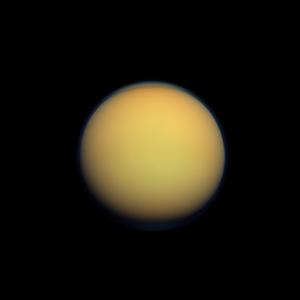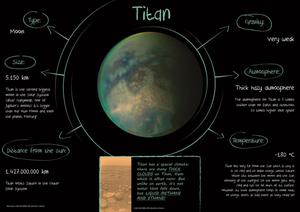Glossary term: Titan
Description: Titan est la plus grande lune de Saturne. Elle est plus grande que la Lune de la Terre et que Mercure, et se classe au deuxième rang des lunes du système solaire. C'est le seul corps autre que la Terre dont on sait qu'il possède des océans, des mers et des rivières liquides à sa surface. Ceux-ci sont toutefois constitués de substances chimiques appelées hydrocarbures. On pense que Titan possède un noyau rocheux et une croûte de glace composée d'eau. On pense que l'eau liquide sous la croûte de glace pourrait abriter de la vie. Titan possède une atmosphère épaisse, composée principalement d'azote, qui lui donne un aspect très lisse sur les images.
Related Terms:
See this term in other languages
Term and definition status: The original definition of this term in English have been approved by a research astronomer and a teacher The translation of this term and its definition is still awaiting approval
The OAE Multilingual Glossary is a project of the IAU Office of Astronomy for Education (OAE) in collaboration with the IAU Office of Astronomy Outreach (OAO). The terms and definitions were chosen, written and reviewed by a collective effort from the OAE, the OAE Centers and Nodes, the OAE National Astronomy Education Coordinators (NAECs) and other volunteers. You can find a full list of credits here. All glossary terms and their definitions are released under a Creative Commons CC BY-4.0 license and should be credited to "IAU OAE".
If you notice a factual or translation error in this glossary term or definition then please get in touch.
Related Media
Titan en couleurs naturelles
Credit: NASA/JPL-Caltech/Space Science Institute credit link
License: PD Public Domain icons
Titan avec structures en surface
Credit: NASA/JPL/Université d'Arizona/Université d'Idaho credit link
License: PD Public Domain icons
Related Activities
Children's Planetary Maps: Titan
astroEDU educational activity (links to astroEDU website) Description: Learn about the only other known body in the Solar System with Seas and Lakes
License: CC-BY-4.0 Creative Commons Attribution 4.0 International (CC BY 4.0) icons
Tags:
Maps
, Planetary cartography
, Spatial thinking
Age Ranges:
6-8
, 8-10
, 10-12
Education Level:
Middle School
, Primary
, Secondary
Areas of Learning:
Social Research
Costs:
Low Cost
Duration:
2 hours
Group Size:
Group
Skills:
Analysing and interpreting data
, Asking questions
, Communicating information
, Constructing explanations
, Developing and using models
, Engaging in argument from evidence
, Planning and carrying out investigations











